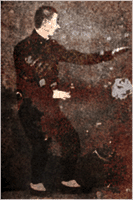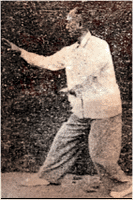<--- | --->

Sun Lu Tang

Jiang Rong Qiao

Chen Pan Ling
Element: Metal
Organ: Lungs
Power: Axe
Energy: Splitting, rending, cleaving or tearing apart; swinging upwards or chopping forward and down like an axe
Step-by-Step Walkthrough

Pi Quan is first of the five elements. It's beginning stance is identical to
San Ti. It corresponds to the lungs in the Wu Xing and therefore belongs to
Metal. When Metal is concealed inside, the nose connects to the lungs, expanding
and compressing them with each movement.
When you make the Pi movement, and, in fact, when you do any of the five movements,
one hand pulls in to the abdomen. This balances the physical movement of the
other arm, but it also helps you to draw Qi into your Dan Tian and accumulate
it there.
Pi Quan may vary depending on the style, especially in the beginning movements
of the form. Some families use large movements drawing the fists to the side
of the body while twisting the torso, while others, like ours, are smaller and
tigher, bringing the fists down to the Dan Tien while keeping the upper body
facing forward.
Song of Pi Quan
The two fists are like embracing and move toward the mouth. The fist is drilling
upward the same height as the eyebrows. The latter fist follows closely and
connects tightly. The two arms are embracing the sides as high as the heart.
The Qi falls to the Dan Tian following the body movements. Two hands fall together
as the rear foot follows. Four fingers are open and the tiger mouth is round.
The high and low of the front hand is the same as the heart.
The rear hand is always hidden under the armpit. The tips of the hands, foot
and nose are lined up. The little finger is turned upward as high as the eyebrows.
The method of the Pi Quan strike is drilling upward. The feet and hands fall
together and the tongue is pressing upward. Step and exchange the forms, the
Yin palm is falling.
Variations
of the Wu Xing
As you can see in the pictures to the left, the basic posture of Pi Quan, which
is identical to San Ti Shi, differed slightly depending on the master. The postioning
of the hands may have varied, but were always on lined up on the same vertical
plane, keeping true to the "Three Points" rule. The width of the gate
between the legs also varied, but once again, all three masters stay true to
the basic Xingyi principles. All three of these masters were Hebei stylists,
and all three performed the fists with in a way that was comfortable and right
for them.
<--- | --->